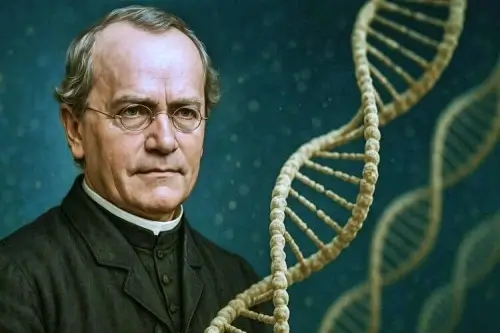Genes. Have you ever wondered why some people have brown eyes while others have blue? Or why some individuals effortlessly maintain a lean physique, while others seem to gain weight just by looking at food?
The answer lies within our genes. These minuscule segments of DNA orchestrate nearly every function in our bodies, from the color of our hair to our susceptibility to diseases like diabetes.
While even schoolchildren today are familiar with the concept of genes, there was a time when the very idea of a detailed human instruction manual hidden within each cell was beyond human comprehension.
So, when exactly did scientists first unravel the mystery of our genes?
Genes, the Earliest Glimmers.
A Monk, Pea Plants, and a Revolutionary Idea.
The notion that traits are passed down through generations is ancient, but the true saga of gene discovery began with a humble monk cultivating pea plants.
In 1865, Gregor Mendel meticulously observed that characteristics in plants didn’t blend but rather seemed to be inherited as distinct “blocks.”
At the time, no one grasped the sheer revolutionary nature of his findings. His work, though groundbreaking, remained largely unappreciated for decades.
It took more than 40 years for a Danish botanist, Wilhelm Johannsen, to bestow a name upon these enigmatic hereditary factors: “genes.”
This marked the beginning of a prolonged journey, transforming an abstract concept into tangible molecules residing within human cells. Johannsen’s coinage of the term “gene” provided a crucial linguistic anchor, allowing scientists to conceptualize and discuss these fundamental units of heredity.
Pinpointing the Location.
Genes Find Their “Address”.
The early 20th century brought another pivotal breakthrough. In 1910, Thomas Hunt Morgan conducted ingenious experiments with fruit flies, Drosophila melanogaster.
His research conclusively demonstrated that genes weren’t disembodied entities floating freely but were, in fact, located on chromosomes.
This was akin to discovering the “address” of genes within the cell. Scientists quickly deduced that if this held true for fruit flies, it was highly probable the same applied to humans. However, directly visualizing human genes at that time was impossible, so inferences were drawn from indirect evidence.
A critical turning point arrived with the realization that a disease could be triggered by the malfunction of a single gene. In 1949, Linus Pauling provided groundbreaking evidence that sickle cell anemia was the direct result of a structural defect in the hemoglobin protein.
This marked the first instance where a human genetic mutation transcended theoretical speculation and became a concrete, verifiable fact. Genetics had finally ascended to the molecular level, bridging the gap between abstract concepts and observable biological realities.
The Double Helix.
Unveiling the Structure of DNA.
The year 1953 witnessed an epoch-making discovery: James Watson and Francis Crick unveiled the intricate structure of the DNA molecule. Their revolutionary double helix model provided the blueprint for how genes store and transmit genetic information.
This elegant structure explained the mechanisms of heredity with unprecedented clarity. A few years later, it was definitively established that humans possess precisely 46 chromosomes – these “shelves,” as it were, housing all of our genes.
The final piece of the puzzle was to prove that these genes could not only be identified but also copied.
This remarkable feat occurred in 1978 when scientists successfully cloned the first human gene – the insulin gene. This achievement unequivocally demonstrated that genes were not merely philosophical ideas or scientific hypotheses but concrete segments of DNA that could be manipulated and studied directly.
With this groundbreaking success, humanity was definitively convinced: we possess genes, and we even have the ability to interact with them.
In essence, humanity’s understanding of genes unfolded step by step, from Mendel’s pioneering experiments in 1865 to the deciphering of DNA’s structure and the cloning of the first human gene in the 20th century.
Today, our knowledge extends far beyond simply knowing that genes exist; we are adept at researching, editing, and even treating rare diseases by targeting these fundamental units of life.
This profound discovery has revolutionized medicine, offering us the unprecedented ability to peer into our genetic future and comprehend the very essence of who we are.
Gene Editing in Action.
A Modern Medical Miracle.
The nascent field of gene editing is already making headlines, ushering in a new era of medical possibilities. In a truly groundbreaking case, doctors have achieved a historical milestone by saving a child afflicted with a rare, fatal disease by literally rewriting his genes.
The boy was diagnosed shortly after birth with a rare genetic disorder: CPS1 enzyme deficiency.
This enzyme is crucial for breaking down ammonia in the body. Without it, the toxic substance accumulates in the bloodstream, poisoning the brain. Tragically, half of the children born with this diagnosis succumb to the illness in infancy, as conventional treatments offer little reprieve.
Doctors in the United States embarked on an unprecedented course of action. They harnessed the revolutionary CRISPR technology, which allows for precise editing of human genes.
Their objective was to “repair” one of the two copies of the damaged gene, a correction they hoped would be sufficient to save the child’s life.
The development of this bespoke treatment was remarkably swift, taking only a few dozen days. At just six months old, the young patient received his first dose of the gene-editing drug, followed by two more doses in March and April.
While the results are still preliminary, they offer profound hope: science is indeed beginning to work wonders. This remarkable case study, as reported by New Scientist, signifies a paradigm shift in medicine.
The ability to precisely target and modify a single defective gene to combat a life-threatening condition marks a monumental leap forward. This new era of medicine, barely in its infancy, is already demonstrating its potential to save lives and transform the landscape of human health.
This incredible progress in gene editing raises exciting questions about the future of medicine. What other diseases might we be able to conquer with these revolutionary techniques?
Have a Great Day!





